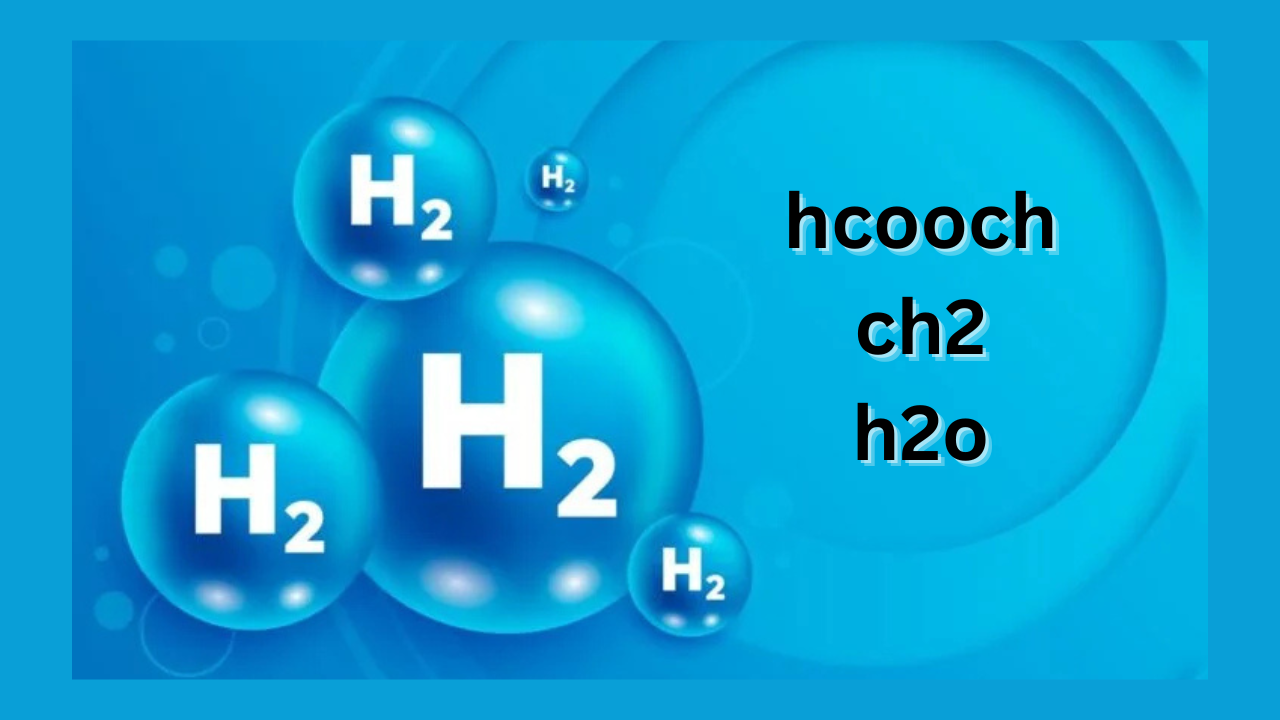The compound hcooch ch2 h2o is a fascinating subject in the world of chemistry due to its complex interactions and unique properties. Understanding how this compound works requires delving into its chemical structure, behavior in different environments, and its practical applications in various industries. This article will provide an in-depth analysis, starting with its molecular composition, moving on to its properties, and concluding with its uses and significance.
Understanding the Molecular Structure of hcooch ch2 h2o
The molecular formula hcooch ch2 h2o represents a compound containing functional groups such as hydroxyl (-OH), carbonyl (C=O), and other organic components. Breaking down this compound gives insights into its chemical behavior.
- Formate Group (HCOOCH):
The formate group is a derivative of formic acid, which is known for its reactive carbonyl group. This part of the molecule plays a significant role in its reactivity and interaction with other compounds. - Methylene Group (CH2):
The methylene group acts as a bridge between different functional groups, influencing the stability and solubility of the compound. Its flexibility allows for diverse chemical reactions, especially in organic synthesis. - Water Molecule (H2O):
The presence of water in the molecular structure enhances the compound’s ability to participate in hydration and hydrolysis reactions. It also affects its physical state, solubility, and stability under various conditions.
Together, these components create a compound with unique properties, making it valuable for both academic research and industrial applications.
Physical and Chemical Properties of hcooch ch2 h2o
Physical Properties
- Appearance: The compound may exist as a clear liquid or a crystalline solid, depending on environmental conditions such as temperature and pressure.
- Solubility: Due to the presence of hydrophilic groups, it exhibits high solubility in water and other polar solvents.
- Boiling and Melting Points: The exact values depend on the specific structural arrangement but are influenced by the intermolecular forces, such as hydrogen bonding.
Chemical Properties
- Reactivity: The compound’s functional groups make it highly reactive in organic reactions. It can act as a nucleophile or electrophile, depending on the conditions.
- Hydrolysis: In aqueous solutions, the compound undergoes hydrolysis, breaking down into smaller components that are useful in various chemical processes.
- Stability: It remains stable under standard conditions but may decompose under extreme heat or in the presence of strong acids or bases.
These properties highlight its versatility and make it an essential compound for multiple applications.
Applications of hcooch ch2 h2o
The unique structure and properties of hcooch ch2 h2o enable its use in a wide range of industries.
1. Pharmaceutical Industry
The compound is utilized as an intermediate in the synthesis of drugs and other bioactive molecules. Its reactive groups allow for the formation of complex molecular structures, which are critical in drug design and production.
2. Agricultural Sector
In agriculture, it is used in the formulation of fertilizers and pesticides. Its ability to break down into non-toxic byproducts makes it environmentally friendly and safe for widespread use.
3. Chemical Synthesis
The compound serves as a building block in organic synthesis. It facilitates the production of polymers, resins, and other materials that are essential in manufacturing industries.
4. Environmental Applications
Due to its biodegradable nature, hcooch ch2 h2o is used in processes aimed at reducing environmental pollution. It helps in the breakdown of harmful chemicals and the restoration of ecosystems.
Interaction of hcooch ch2 h2o with Other Compounds
The behavior of hcooch ch2 h2o in chemical reactions is influenced by its interaction with other substances.
- Acid-Base Reactions:
The compound can act as a proton donor or acceptor, depending on the pH of the solution. This property is crucial in catalysis and pH regulation processes. - Oxidation-Reduction Reactions:
The presence of carbonyl and hydroxyl groups allows the compound to participate in redox reactions, making it useful in energy production and storage systems. - Complex Formation:
The compound can form complexes with metals and other organic molecules, enhancing its functionality in industrial and research applications.
Challenges and Future Perspectives
While hcooch ch2 h2o offers numerous advantages, there are challenges associated with its use.
- Stability Issues:
The compound may degrade under extreme conditions, limiting its applications in certain environments. - Cost of Production:
The synthesis of hcooch ch2 h2o can be expensive, especially when high purity is required. - Environmental Impact:
Although it is biodegradable, improper disposal can lead to short-term environmental concerns.
Future Research Directions
Advancements in synthetic chemistry and green technologies aim to address these challenges. Researchers are exploring cost-effective production methods and improved stabilization techniques to expand its applications further.
Role of hcooch ch2 h2o in Organic Chemistry
Organic chemistry often relies on compounds like hcooch ch2 h2o due to their multifunctionality. The compound’s carbonyl group serves as a reaction center for nucleophilic additions, while the hydroxyl group allows for esterification and condensation reactions. This versatility makes it an essential reagent in synthesizing complex organic molecules. In addition, its water component facilitates hydrolysis and hydration reactions, making it an ideal candidate for laboratory experiments. Researchers frequently use it as a precursor to produce other organic compounds, further demonstrating its importance in organic synthesis.
Environmental Decomposition and Biodegradability
A significant advantage of hcooch ch2 h2o is its ability to decompose into environmentally benign byproducts. When exposed to microbial activity or natural environmental conditions, the compound breaks down into smaller, non-toxic components, minimizing its ecological footprint. This property makes it suitable for applications in biodegradable products, reducing long-term pollution risks. Moreover, its decomposition process aligns with sustainable practices, making it an attractive choice for industries seeking eco-friendly solutions.
Industrial Manufacturing and Processing
Industries value hcooch ch2 h2o for its role in manufacturing various materials. In polymer production, it acts as a stabilizer and catalyst, ensuring the desired molecular structure is achieved. It is also used in the production of adhesives and coatings, contributing to improved durability and performance. Its ability to interact with other compounds seamlessly has made it a critical component in industrial processes requiring precision and efficiency.
hcooch ch2 h2o in Food Chemistry
In food chemistry, hcooch ch2 h2o plays a role as a preservative and flavor enhancer. Its water solubility and stability allow it to integrate into food formulations easily. Additionally, its ability to undergo controlled hydrolysis enables the slow release of flavor compounds, improving the sensory qualities of processed foods. However, its use is strictly regulated to ensure safety and compliance with food industry standards.
Pharmacological Significance
The pharmacological applications of hcooch ch2 h2o are significant due to its reactivity and compatibility with biological systems. It is used as an intermediate in synthesizing active pharmaceutical ingredients (APIs), where its functional groups enable the formation of therapeutic compounds. Moreover, its role in drug delivery systems is being explored, as its water solubility and chemical stability make it suitable for developing controlled-release medications.
hcooch ch2 h2o in Energy Storage and Conversion
The compound is gaining attention in energy-related applications, particularly in batteries and fuel cells. Its ability to participate in redox reactions makes it a potential candidate for energy storage systems. Researchers are investigating its role in enhancing the efficiency and longevity of fuel cells, particularly in hydrogen-based energy systems. Its compatibility with renewable energy technologies positions it as a promising solution for sustainable energy production.
These additional subheadings provide a more comprehensive view of the significance and diverse applications of hcooch ch2 h2o, showcasing its relevance in various fields.
Conclusion
The compound hcooch ch2 h2o is a remarkable chemical entity with a wide range of properties and applications. Its unique molecular structure allows it to participate in various chemical reactions, making it invaluable in industries such as pharmaceuticals, agriculture, and environmental science. Despite some challenges, ongoing research continues to unlock its full potential, ensuring its relevance in both academic and industrial settings. Understanding how hcooch ch2 h2o works not only enhances our knowledge of chemistry but also paves the way for innovative solutions to global challenges.










